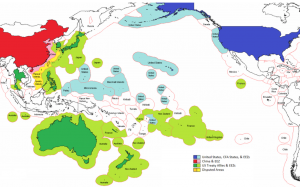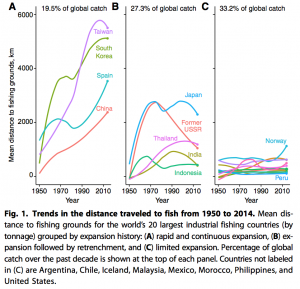Assessment of Global Fishing Fleets
By Olivia Wigon, SRC intern
Populations of fish close to coasts have declined, forcing the fishing industry to go farther and farther from shore in order to keep up with demand. David Tickler and his team wanted to understand who is fishing where and how much are they catching. Originally, most fishing was done locally, with countries fishing off their own coasts. However, with industrialization during the 19th century came the opportunity to fish in the open ocean. At first, the adoption of engine-powered trawlers was seen as beneficial because of the increased catch, but quickly there began to be signs of decreasing coastal fish stocks. As the fish stocks along the coast decreased more and more, ships turned toward the open ocean. This led to problems between domestic and foreign vessels since there were no rules on who had legal control of these waters. In 1982 the United Nations Convention on the Law of the Sea (UNCLOS) was established in order to cut down on this problem. UNCLOS stated that each country had control over 200-nautical miles from its shore, which is called is exclusive economic zone (EEZ). With the advent of new fishing technology in the late 20th century, such as long-range navigation (LORAN), radar and sonar, fishing vessels were able to head out even farther from port.

Figure 1. Map of the Exclusive Economic Zones (EEZ’s) of countries in the pacific (Source: Tickler et al. 2018)
To analyze and understand the effects of long-range fishing fleets, David Tickler and his lab compiled data about the average distance fishing ships travel for the 20 largest fishing countries. Data was collected from 1950 until 2014 and was then broken up into three groups: the countries that had continuous rapid expansion (ex. Taiwan), the countries that had a fast expansion but then tapered off (ex. Japan), and lastly the countries that have had very little expansion (ex. Norway). Additional data was analyzed to understand the amount of fish caught per distance traveled from 1950 to 2014. This data showed that there is an overall significant decline in catch. The data showed that after 1996 the oceans became exploited to the point that the catch per unit area and the total industrial catch began to continuously decrease.

Figure 2. (Source: Tickler et al. 2018)
Ocean exploitation not only affects fishermen and federal governments but has a major effect on everyone. As global fish stocks decrease there are not only less fish in the sea but smaller profits in the fishing industry. To keep the long-haul distant-water fishing industry alive many countries have resorted to providing subsidies for ships, fuel and general fleet support. There is a direct correlation between the average distance a country travels to fish, and the amount of subsidies provided. However, without these subsidies the profits nearly vanish for distant water fishing. In order to help solve this issue we must urge governments to decrease their subsidies, especially in the countries that fish the farthest from port. This will not only help prevent unprofitable fishing but will also decrease income inequality in various fishing countries. Although the ocean was thought of as a limitless resource, we must now recognize the limitations of our consumption.
Work Cited
D. Tickler, J. J. Meeuwig, M.-L. Palomares, D. Pauly, D. Zeller, Far from home: Distance patterns of global fishing fleets. Sci. Adv. 4, eaar3279 (2018).
